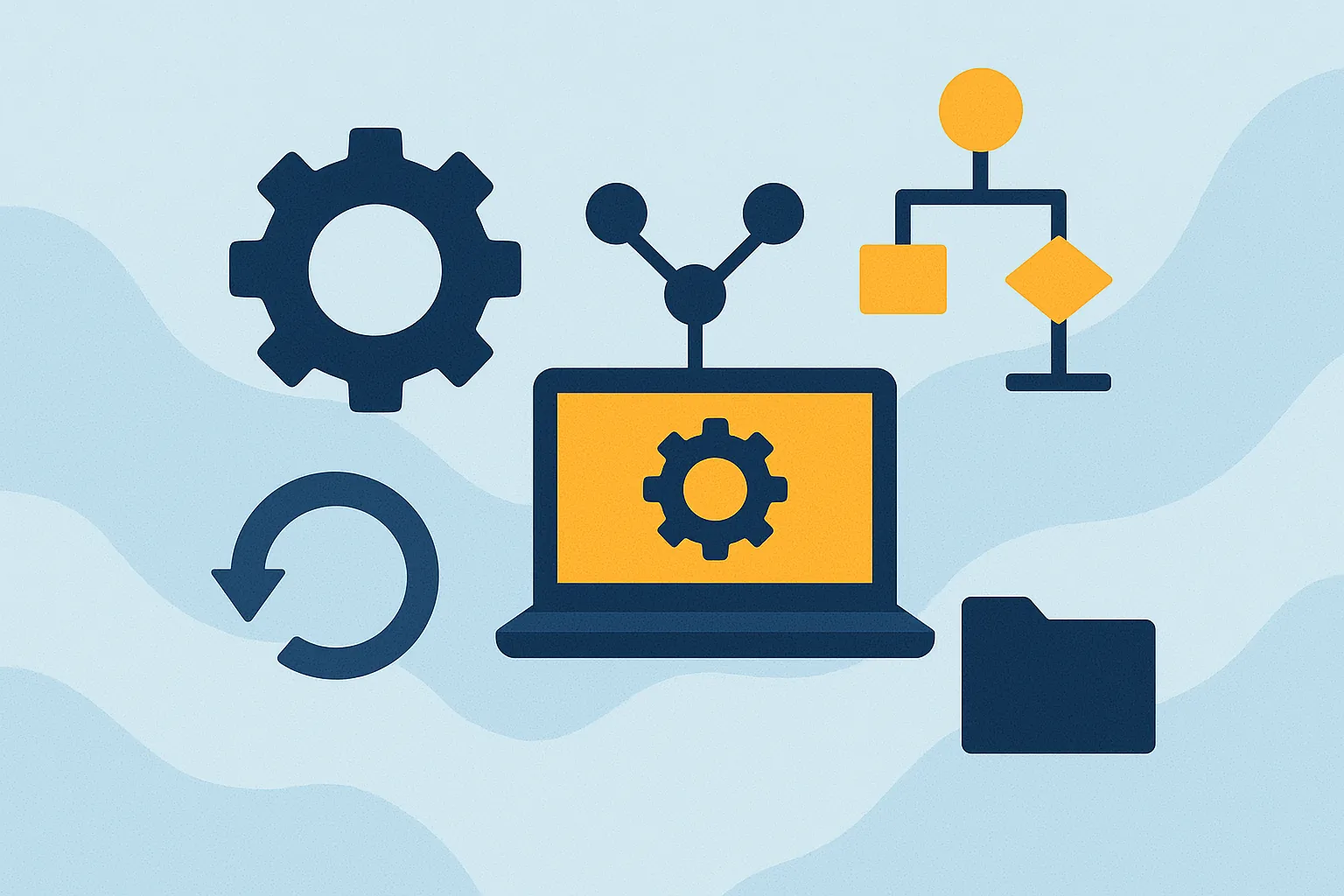Introduction
In Agile and Waterfall methodologies, the concepts of configuration management and change management play pivotal roles in ensuring project success. Understanding these two distinct yet interrelated processes is essential for project managers aiming to navigate the complexities of their projects effectively.
Defining Configuration Management and Change Management
Configuration management refers to the systematic process of identifying, documenting, and controlling the configuration items (CIs) within an organization’s IT infrastructure. This includes maintaining the integrity and performance of these items throughout their lifecycle, ensuring that any changes made do not disrupt the overall system functionality [14]. On the other hand, change management focuses on managing and controlling changes to project plans, processes, and baselines to minimize disruptions and ensure that any alterations are beneficial to the project’s objectives [15].
The Importance of Understanding the Difference
Recognizing the distinction between configuration management and change management is crucial for several reasons. Firstly, while change management addresses unexpected changes and their impacts on project delivery, configuration management proactively manages the specifications of the product, ensuring that all components are aligned and functioning as intended [5][6]. This understanding helps project managers implement appropriate strategies that cater to the specific needs of their projects, ultimately leading to improved efficiency and effectiveness.
Comparing Configuration Management Practices in Agile vs. Waterfall
The main focus of this discussion will be to compare how configuration management practices differ between Agile and Waterfall methodologies. Agile projects, characterized by their iterative and flexible nature, often require a more dynamic approach to configuration management, allowing for rapid adjustments and continuous integration. In contrast, Waterfall projects, with their linear and structured phases, necessitate a more rigid configuration management process to maintain control over the project’s scope and deliverables. By exploring these differences, project managers can better tailor their configuration management strategies to align with the specific demands of their chosen methodology, ensuring a smoother project execution and delivery.
Understanding Configuration Management
Configuration management (CM) is a critical discipline within project management that focuses on systematically managing and controlling the various components of a project. It ensures that the project’s integrity and quality are maintained throughout its lifecycle, regardless of the methodology employed—be it Agile or Waterfall.
Definition of Configuration Management
In the context of project management, configuration management refers to the process of identifying, documenting, and controlling the configuration items (CIs) within a project. These items can include software, hardware, documentation, and any other deliverables that are essential to the project’s success. The primary goal of configuration management is to ensure that the project’s components are consistent and meet the specified requirements, thereby facilitating effective project execution and delivery [3][14].
Components of Configuration Management
Configuration management encompasses several key components that work together to maintain control over project elements:
- Identification: This involves defining and categorizing all configuration items within the project. Each item is assigned a unique identifier to facilitate tracking and management [14].
- Control: Control refers to the processes and procedures established to manage changes to configuration items. This includes ensuring that any modifications are properly reviewed, approved, and documented to prevent unauthorized changes that could impact project integrity [14][10].
- Status Accounting: This component involves maintaining records of the status of configuration items throughout the project lifecycle. It provides visibility into the current state of each item, including any changes made and their implications for the project [14].
- Auditing: Auditing is the process of reviewing and verifying that configuration management practices are being followed correctly. It ensures compliance with established procedures and helps identify any discrepancies that may need to be addressed [14].
Role of Configuration Management in Maintaining Project Integrity and Quality
Configuration management plays a vital role in ensuring the integrity and quality of a project. By systematically managing configuration items, project managers can:
- Prevent Errors: Effective configuration management helps to minimize errors by ensuring that all changes are controlled and documented. This reduces the risk of introducing defects into the project deliverables [12][14].
- Enhance Communication: With clear documentation and status accounting, all stakeholders have access to up-to-date information about the project’s components. This transparency fosters better communication and collaboration among team members [12].
- Facilitate Change Management: Configuration management provides a solid foundation for change management processes. By maintaining a clear baseline of configuration items, project managers can assess the impact of proposed changes and make informed decisions [9][10].
- Support Quality Assurance: By ensuring that all configuration items meet specified requirements, configuration management contributes to the overall quality of the project. It helps in identifying and addressing issues early in the project lifecycle, thereby enhancing the final deliverables [12][14].
Understanding Change Management
Change management is a critical aspect of project management that focuses on managing alterations to project plans, processes, and baselines. Its primary objective is to ensure that any changes made during the project lifecycle are systematically controlled and documented, thereby minimizing disruptions and maintaining project integrity.
Definition and Objectives of Change Management
Change management refers to the structured approach to managing changes in a project. It aims to:
- Facilitate Smooth Transitions: By providing a clear framework for handling changes, it helps teams adapt to new requirements or modifications without significant disruptions.
- Enhance Communication: Change management fosters communication among stakeholders, ensuring that everyone is aware of changes and their implications.
- Maintain Project Integrity: It safeguards the project’s objectives by ensuring that changes align with the overall goals and do not adversely affect the project’s scope, schedule, or budget.
Processes Involved in Change Management
The change management process typically involves several key steps:
- Change Request: This is the initial step where a formal request for change is submitted. It can originate from various stakeholders, including team members, clients, or management.
- Assessment: Once a change request is received, it undergoes a thorough assessment to evaluate its impact on the project. This includes analyzing how the change will affect timelines, resources, and overall project objectives.
- Approval: After assessment, the change request must be approved by relevant stakeholders or a change control board. This step is crucial to ensure that only necessary and beneficial changes are implemented.
- Implementation: Once approved, the change is implemented according to a predefined plan. This may involve updating project documentation, communicating changes to the team, and adjusting project schedules.
Importance of Change Management in Minimizing Disruptions
Effective change management is vital for minimizing disruptions in projects for several reasons:
- Reduces Resistance: By involving stakeholders in the change process and communicating effectively, change management helps reduce resistance to change, making transitions smoother.
- Ensures Compliance: It ensures that all changes are documented and approved, which is essential for compliance with organizational policies and standards.
- Enhances Project Success: By managing changes systematically, projects are more likely to stay on track and meet their objectives, ultimately leading to higher success rates.
Configuration Management in Waterfall Projects
Within the Waterfall methodology, configuration management plays a crucial role in ensuring that all project components are systematically organized and controlled. This section delves into the unique characteristics of configuration management in Waterfall projects, highlighting its structured approach, challenges, and advantages.
Linear and Sequential Nature of Waterfall Methodology
The Waterfall methodology is characterized by its linear and sequential approach to project development. Each phase of the project must be completed before the next one begins, creating a clear and defined path from requirements gathering to deployment. This structure necessitates a robust configuration management process to maintain order and ensure that all project elements are aligned with the established plan. The sequential nature of Waterfall means that any changes made in later stages can have significant implications for earlier phases, making effective configuration management essential to avoid disruptions and maintain project integrity [10][12].
Structured Approach to Configuration Management
In Waterfall projects, configuration management is implemented through a highly structured approach. This involves:
- Documentation: Comprehensive documentation is a cornerstone of configuration management in Waterfall. Each configuration item (CI) must be meticulously documented, including its specifications, versions, and relationships to other items. This documentation serves as a reference point throughout the project lifecycle, ensuring that all team members are on the same page regarding the project’s status and requirements [3][9].
- Change Control: A formal change control process is integral to configuration management in Waterfall. Any proposed changes must go through a rigorous evaluation process to assess their impact on the project. This includes analyzing how changes will affect timelines, costs, and overall project objectives. By controlling changes in this manner, project managers can mitigate risks and maintain project stability [4][9].
Challenges and Advantages of Configuration Management in Waterfall
While the structured approach to configuration management in Waterfall projects offers several advantages, it also presents unique challenges:
Challenges:
- Rigidity: The linear nature of Waterfall can make it difficult to accommodate changes once a phase is completed. This rigidity can lead to delays if significant changes are required late in the project [12].
- Documentation Overhead: The emphasis on documentation can create an administrative burden, consuming valuable time and resources that could be spent on project execution [3][9].
Advantages:
- Clarity and Control: The structured approach provides clarity and control over project components, making it easier to track progress and ensure compliance with project specifications [4][9].
- Risk Mitigation: By implementing a formal change control process, Waterfall projects can better manage risks associated with changes, ensuring that any modifications are carefully considered and documented [4][9].
Configuration Management in Agile Projects
In Agile methodologies, configuration management plays a crucial role in ensuring that project components are systematically identified, documented, and controlled. Understanding how configuration management differs in Agile projects compared to traditional methodologies like Waterfall is essential for project managers aiming to navigate the complexities of modern project environments.
Iterative and Flexible Nature of Agile Methodology
Agile methodology is characterized by its iterative and flexible approach, allowing teams to adapt to changes quickly and efficiently. Unlike the linear progression of Waterfall, Agile promotes short development cycles known as sprints, which enable teams to reassess project goals and deliverables regularly. This flexibility is vital in today’s fast-paced business environment, where customer needs and market conditions can shift rapidly. As a result, configuration management in Agile must be equally adaptable, ensuring that all configuration items (CIs) are updated in real-time to reflect ongoing changes and enhancements [5][9].
Adapting Configuration Management for Frequent Changes
In Agile projects, configuration management practices are tailored to accommodate the frequent changes that arise from iterative development and continuous customer feedback. This involves:
- Dynamic Documentation: Agile teams often utilize lightweight documentation practices that evolve alongside the project. This ensures that configuration records remain relevant and accurate, reflecting the latest project state [6].
- Version Control Systems: Tools like Git are commonly employed to manage changes in code and documentation, allowing teams to track modifications and revert to previous versions if necessary. This is crucial for maintaining the integrity of the project as it evolves [9].
- Regular Reviews: Agile emphasizes regular reviews and retrospectives, which provide opportunities to assess configuration management practices and make necessary adjustments to improve efficiency and effectiveness [4].
Benefits and Challenges of Configuration Management in Agile
While Agile configuration management offers numerous benefits, it also presents unique challenges:
Benefits:
- Enhanced Collaboration: Agile fosters a collaborative environment where team members work closely together, leading to improved communication and shared understanding of configuration items. This collaboration is essential for effective configuration management, as it ensures that all team members are aligned on project goals and changes [8].
- Continuous Integration: Agile practices often include continuous integration, where code changes are automatically tested and integrated into the main project branch. This not only accelerates the development process but also helps maintain a stable configuration throughout the project lifecycle [7].
Challenges:
- Managing Complexity: As Agile projects evolve, the number of configuration items can increase significantly, making it challenging to maintain an accurate and comprehensive configuration management system. Project managers must implement robust strategies to manage this complexity effectively [9].
- Balancing Flexibility and Control: While Agile promotes flexibility, it is essential to maintain a level of control over configuration management to prevent chaos. Striking the right balance between adaptability and structure is crucial for successful project outcomes [6][8].
Comparative Analysis: Agile vs. Waterfall
Understanding the differences between configuration management and change management is crucial, especially when considering the methodologies employed—Agile and Waterfall. Each methodology presents unique approaches to configuration management, impacting how project managers handle documentation, communication, and the tools they utilize.
Structure and Documentation Requirements
- Waterfall Methodology: This approach is linear and sequential, emphasizing thorough documentation at each phase of the project. Configuration management in Waterfall requires detailed records of configuration items (CIs) and their relationships, ensuring that all changes are documented before moving to the next phase. This structured documentation is essential for maintaining consistency and traceability throughout the project lifecycle [8][9].
- Agile Methodology: In contrast, Agile is more flexible and iterative, allowing for changes to be made at any stage of the project. Documentation in Agile is often less formal and can be more adaptive, focusing on essential information that supports ongoing development. Configuration management practices in Agile prioritize real-time updates and collaborative documentation, which can lead to a more dynamic approach to managing configurations [10][12].
Communication and Collaboration
- Waterfall Communication: Communication in Waterfall projects tends to be more formal and structured, with defined roles and responsibilities. This can lead to a more siloed approach to configuration management, where information is shared primarily through documentation and scheduled meetings. The emphasis on following a predetermined plan can sometimes hinder quick responses to configuration changes [4][8].
- Agile Collaboration: Agile methodologies promote continuous communication and collaboration among team members. Daily stand-ups and iterative reviews facilitate immediate feedback and adjustments to configurations. This collaborative environment allows for quicker identification and resolution of configuration issues, fostering a culture of shared responsibility for configuration management [7][10].
Tools and Technologies
- Waterfall Tools: In Waterfall projects, configuration management tools are often robust and designed to handle extensive documentation and version control. These tools support the structured nature of Waterfall, ensuring that all changes are tracked and that the project adheres to its defined scope and schedule [9][10].
- Agile Tools: Agile projects leverage a variety of tools that support flexibility and real-time collaboration. Tools like Jira or Trello facilitate quick updates and allow teams to manage configurations dynamically. These tools are designed to integrate with other Agile practices, enabling teams to adapt their configuration management processes as the project evolves [7][8].
Best Practices for Effective Configuration Management
In Agile and Waterfall methodologies, understanding the nuances of configuration management (CM) is crucial. While both methodologies have their unique approaches, certain best practices can enhance configuration management strategies across the board. Here are some key points to consider:
Key Best Practices for Configuration Management
- Utilize a Configuration Management Database (CMDB): Implementing a CMDB is essential for both Agile and Waterfall projects. It serves as a centralized repository that stores and manages information about the configurations of your IT infrastructure, ensuring consistency and traceability across systems [5].
- Establish Clear Processes: Develop a structured process for incident management and rollback. This is particularly important in Agile environments where rapid changes are common. Having a clear protocol allows teams to quickly address configuration issues as they arise, minimizing disruptions [4].
- Regular Audits and Reviews: Conduct frequent inspections of configurations to ensure they align with project goals and customer needs. This practice is beneficial in both methodologies, as it allows for timely adaptations based on feedback and changing requirements [15].
- Define Roles and Responsibilities: Clearly outline the roles and responsibilities of team members involved in configuration management. This clarity helps in maintaining accountability and ensures that everyone understands their part in the process [10].
Importance of Training and Skill Development
- Continuous Learning: Training is vital for team members to stay updated on the latest configuration management practices and tools. Regular workshops and training sessions can enhance their skills, enabling them to effectively manage configurations in both Agile and Waterfall settings [11].
- Promote a Culture of Best Practices: Awareness sessions can reinforce the importance of configuration management and highlight the risks associated with poor practices. This cultural shift encourages adherence to best practices across the team [4].
Encouraging the Use of Automated Tools and Techniques
- Leverage Automation: Utilizing automated tools can significantly streamline configuration management processes. Automation reduces the likelihood of human error and allows for more efficient tracking and updating of configurations [1].
- Integrate with Project Management Tools: Tools like Jira can facilitate better communication and collaboration among team members, especially in Agile projects. These tools can help manage configurations alongside project tasks, ensuring that all changes are documented and tracked effectively [8].
By implementing these best practices, project managers can enhance their configuration management strategies, leading to more successful project outcomes in both Agile and Waterfall environments. The focus on training, automation, and clear processes will not only improve efficiency but also foster a culture of continuous improvement within project teams.
Conclusion
Understanding the differences between configuration management and change management is crucial, especially when considering the methodologies employed—Agile and Waterfall. Here’s a recap of the key distinctions and their implications for effective project execution:
- Differences in Configuration Management: In Agile projects, configuration management is often more dynamic and iterative, allowing for frequent updates and adjustments as the project evolves. This flexibility supports the Agile principle of responding to change over following a fixed plan. Conversely, in Waterfall projects, configuration management tends to be more structured and sequential, focusing on maintaining control over the project’s defined scope and specifications throughout its linear progression. This approach ensures that all changes are documented and approved before implementation, which is essential in a more rigid framework.
- Significance of Alignment: Aligning configuration management practices with the chosen project methodology is vital for success. Agile project managers must embrace a more fluid approach to configuration management that accommodates rapid changes and continuous feedback. In contrast, Waterfall project managers should prioritize thorough documentation and strict adherence to established processes to maintain product integrity and minimize disruptions. This alignment not only enhances project efficiency but also fosters better communication among team members and stakeholders.
- Encouragement for Adaptation: Project managers are encouraged to regularly assess and adapt their configuration management strategies based on the specific needs of their projects. This may involve integrating tools and practices that facilitate collaboration and flexibility in Agile environments or reinforcing documentation and approval processes in Waterfall settings. By tailoring configuration management approaches to fit the project context, managers can better navigate challenges and drive project success.
In summary, effective configuration management is a cornerstone of successful project management, regardless of the methodology employed. By understanding the differences between Agile and Waterfall practices and aligning strategies accordingly, project managers can enhance their ability to manage changes, maintain product integrity, and ultimately achieve their project goals.
Find out more about Shaun Stoltz https://www.shaunstoltz.com/about/.
This post was written by an AI and reviewed/edited by a human.



